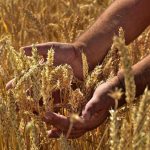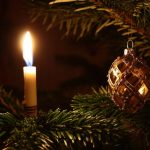Mabon, the second of three harvest festivals, falls on the Autumn Equinox (Lammas, Mabon, and Samhain). At Mabon, days and nights are of equal length, just like they are at Ostara, the opposite side of the Wheel of the Year. This is due to the fact that the Earth is inclined perpendicular to the sun and that the sun is directly above the equator.
Night and day are of equal duration and are in perfect balance – dark and light, masculine and feminine, are all in harmony. It is also called the Pagan Thanksgiving and is a time of balance, equality, and peace.
The term “Equinox” is derived from the Latin words “aequi” (equal) and “nox” (night). The autumnal equinox, also known as Mabon, occurs on or around September 21, while its counterpart in the spring occurs around March 21.
The actual moment of the Equinox, however, fluctuates from year to year. The reason for this is a minor discrepancy between the Gregorian calendar and the actual pace of the Earth’s rotation around the sun. The Equinox also happens at different local times, so it may fall the day before or after the date mentioned on any given calendar, depending on where you reside. Due to this, references to the Wheel of the Year frequently cite the 21-24 September date period.
In the days after the autumn equinox, the days will start to become shorter and the nights longer if you’re in the northern hemisphere; the opposite is true in the southern hemisphere.
Again, we’re on the edge of a change, and from now on, darkness will start to win over light. The natural world’s cycle is nearing completion; the Sun’s strength is decreasing, and the nights are getting longer while the days are getting shorter and cooler.
Fact: Mabon season is often defined as September 20th to September 30th, however in other ways it stretches until Samhain, at the end of October.
Aidan Kelly, a Wiccan novelist, popularized the word Mabon in the 1970s. He thought the equinox and solstice celebrations should have names similar to the Celtic fire festivals. According to his study, Stonehedge was used to predict the timing of the Autumn Equinox at least 3000 years ago. This demonstrates that ancient pagans considered the Autumn Equinox to be a significant day.
He also investigated several Greek, Hebrew, and Germanic traditions in search of appropriate names for the Autumn Equinox. He finally settled on the Mabon myth from Wales. It’s all a part of a modernized version of Paganism.
So the festival is now called Mabon, after the god of Welsh mythology. He is the Son of Modron, the Earth Mother Goddess, and the Child of Light.
Mabon is a harvest celebration. The ancient Celts and pagans celebrated this day by thanking nature for a bountiful harvest and praying to their gods and goddesses that the grain would endure through the winter.
In the past, pagans often used the apple as a symbol of the end of the harvest. In many cultures, this time of year is called the Fruit Harvest, and people who go pumpkin or apple picking during this time may be unknowingly taking part in an ancient festival.
The notion of balance is emphasized here, just as it was during Ostara, serving as a reminder that everything is transitory, that no season lasts forever, and that neither darkness nor light ever completely dominate the other for very long.
The Autumn Equinox serves as a reminder of the Goddess’ entrance into the Underworld. As a result, the spirit of nature is beginning to fade, and winter is getting closer.
So Mabon is both a celebration and a time of rest following the effort of harvest. It is time to harvest what you have sown; to reflect on the goals and aspirations of Imbolc and Ostara and how they have manifested.
In order to fully appreciate the quiet and introspection that the coming winter season might provide, now is the time to finish up tasks and let go of things that are no longer required or wanted. And now is the time to sow seeds of new thoughts and dreams that will remain dormant but nurtured in the dark until spring returns.
Fact: From Mabon through Yule in the second part of December, the days will continue to become progressively darker as we prepare for the next long, cold winter months.
Mabon Origins and History
Many cultures have some sort of harvest festival around the time of the fall equinox. People have been celebrating it for millennia all across the world. Oschophoria was an autumn celebration in ancient Greece that celebrated the harvest of grapes for wine. In the 1700s, the Bavarians started Oktoberfest. It starts in the last week of September and is a time of feasting and fun that is still going on today. The Mid-Autumn Festival in China is held on the night of the Harvest Moon and is a celebration of family connection. Even Thanksgiving in the United States was originally held on October 3rd, which is a date a lot closer to harvest time.
Other names for Mabon include:
- Autumn Equinox
- Equinozio di Autunno (Italy)
- Mehregan (Iran)
- Festival of Dionysus (Greece)
- Harvest Home (England)
- Winter Finding (Nordic)
- The Witches’ Thanksgiving
As was already said, modern Pagans started celebrating Mabon as part of the eight Sabbats in the 1970s, but it has been a harvest festival for thousands of years.
While the harvest season and giving gratitude are not owned by one culture, and there are many distinct festivities that happen around this day, the history of Mabon, in particular, began in Wales and Ancient Ireland!
In Welsh mythology, Mabon was the son of the Earth Mother Goddess. He was the God of Light but was defeated by his twin brother, the God of Darkness.
In Wales, this seasonal change into winter has traditionally been a reason for celebration since balance is essential for life to flourish.
Mabon was shown as a handsome young man with a lyre, just like Apollo. Similar to the Greek myth of Persephone and Demeter, the Roman legend of Proserpina and Ceres, the Sumerian myth of Inanna and Ereshkigal, and many others, Mabon was claimed to have been kept captive in the underworld as a baby.
Almost all of the popular myths and stories during this time of year deal with the concepts of life, death, and rebirth. It is not much of a surprise when you think that this is the time when the earth starts to die before winter arrives.
In fact, the Greek goddess Demeter is much more closely linked to the fall harvest. When she lost her daughter, she was sad, and this made the earth go from being full of life to being cold and empty.
In a few words, the myth of Demeter and Persephone goes like this.
In ancient Greece, Demeter was the goddess of grain and harvest. Hades, the god of the underworld, fell in love with her daughter Persephone. When Hades kidnapped Persephone and carried her to the underworld, Demeter’s grief led to the death and dormancy of all crops on Earth. By the time Demeter got her daughter back, Persephone had already eaten six pomegranate seeds and was doomed to live in the underworld for six months of the year. So, the earth dies throughout these six months, which begin with the fall equinox.
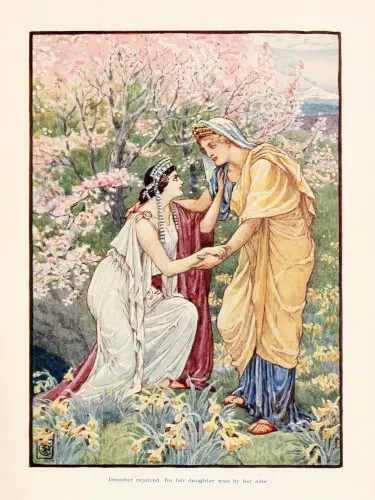
Fact: Pomegranates, as opposed to apples, stand in for the fruit of death that Hades gave to Persephone.
Different rituals and ways of honoring Mabon have been followed in many civilizations across the world. As an example,
There have been notable ceremonial events performed all throughout the British Isles and Ireland to commemorate the last retreat of the harvest spirit, which is symbolically represented by the cutting of the final sheaf. Often, the sheaf was braided to look like a woman, wrapped in a dress with spring-themed ribbons, and hung from a pole, which is a phallic symbol of fertility.
In Scotland, the last sheaf of the harvest is called the Maiden, and the oldest woman at the ceremony has to cut it.
In the Highlands, it was called the Maiden or the Hag, just like a Celtic goddess usually has two faces, one for life and one for death.
The male-female dualism may be replicated with a broomstick. The Harvest Lord is typically depicted as a straw figure whose sacrificial body is burned and the ashes are scattered throughout the earth. The Crop Queen, also known as the Kern Baby, is made from the last sheaf of harvest and is wrapped by reapers yelling, “We have the Kern! “.
After the harvest, everyone gathered to celebrate Mabon with the Maiden Feast, when a toast was made, saying, “Here’s to the one who helped us with the harvest!”, with reference to the decorated sheaf. The sheaf may then be hung for good luck in the farmhouse over the winter or planted into the soil the following year.
September is the “Wine Moon” in the lunar cycle, and it is the time for grape harvesting. The ancient Greeks regarded wine and grapevines as sacred in honor of Dionysus, the god of resurrection. Grapes and wine were seen as emblems of life and rebirth.
Related Reading: The 8 Major Annual Wiccan Holidays (Sabbats) – Opens in new tab
How to celebrate Mabon
Mabon is fundamentally about appreciation for what has been garnered this year, with an eye toward the winter’s trials. Since summer is over and winter is coming, we need to get our minds and bodies ready for the shorter days, longer nights, and harsher conditions that are coming.
There are many different ways to celebrate Mabon depending on your spiritual path, but the focus is usually on the second harvest or the balance of light and dark. After all, this is the time of year when day and night are equal.
Here are a few practices you might wish to consider. Remember that, with a little forethought, any of them may be altered for either a single practitioner or a small group.
Decorating Your Home
Decorating your home for fall is one of the simplest ways to celebrate Mabon. If you don’t have access to your own vegetation, going to the neighborhood farmer’s market or simply taking a quick stroll in the woods will help you find lots of Mabon decorations for your house.
Celebrate with your friends
Organize a Mabon harvest dinner. Encourage everyone to bring a dish or beverage they enjoy to share. Begin some cheerful conversations about what you’re grateful for this year. Create a pleasant, warm atmosphere.
If it’s hard to plan a big party, there’s nothing wrong with having a simple family dinner at the end of a busy day to celebrate Mabon. You may adorn your table with fresh flowers or candles. Take turns expressing your gratitude and your goals for the next year.

Take a Walk
While recognizing the need to leave plenty for everyone else, including the nature spirits, go on a walk and gather as much of nature’s natural bounty as you can. You’ll find wild damsons, sloes, rosehips, elderberries, blackberries, hawthorn berries, and more.
Declutter
Clean your residence to get rid of any stagnant or bad energy. Similar to spring, Mabon is an excellent time to clean the house. After all, you’ll be spending more time here in the fall and winter. Finish any projects you haven’t finished yet and get rid of emotional and physical clutter so your home feels calm, peaceful, and relaxing.
Gratitude Journal
Get yourself a notepad and begin a gratitude journal. Keep a journal of anything that makes you joyful or appreciative. This will undoubtedly improve your mood. Furthermore, it communicates to the universe that you want more of the same.
Donate to Charity
Make a contribution to a local food bank or another food-related charity. While fall is renowned as the season of plenty due to the amount of agricultural commodities harvested at this time of year, the sad reality is that even in a world abundant with food, not everyone gets enough to eat.
If you have non-perishable food items that are still good to offer, the means to donate money, and/or the capacity to give some of your time in volunteer service at a nearby food bank, soup kitchen, or similar institution, Mabon is a great time to help your local charity in any way you can.
Planting Bulbs
It’s a great time to grow tree seedlings and bushes. They have the entire winter to grow and germinate in the darkness. Plant bulbs that will remain hidden in the ground until early spring. Make a spring wish, concept, or desire for each one and wait for their little green noses to appear above ground to remind you!
The Equinox Egg Balancing
It is said that due to the polarity and balance of the earth, if you try to stand an egg on its end on the vernal or autumnal equinox, you will succeed. Let us investigate the fable of the Equinox “egg balancing.”
Are you Alone?
If you’re celebrating Mabon on your own, you may choose a peaceful outdoor spot to meditate and write in a journal before enjoying a delicious meal. Mabon is a perfect opportunity to let go of the old year’s baggage and create some new personal objectives.
Sometimes it seems like each festival requires celebration and gratitude, and this is true. Each turn of the wheel bestows both inner and outer blessings and wisdom.
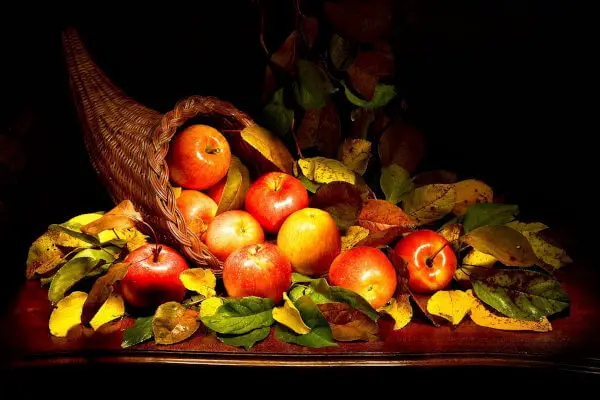
Mabon Symbols
Maybe the most prevalent symbols of Mabon are the cornucopia (horn of plenty) and apples. While pinecones, seeds, hay, pomegranates, and scarecrows are on the list.
The Cornucopia
Mabon is traditionally represented by the cornucopia, also known as the “Horn of Plenty”. It is a magnificent metaphor for harvest prosperity, and it is a beautifully balanced symbol that is both male (phallic) and female (hollow and receptive)
The Apple
The apple is the Fruit Harvest’s emblem. Apple has a significant role in several religious systems and traditions. It represents life and immortality, as well as healing, rejuvenation, regeneration, and completeness. It is connected to youth, beauty, and longevity.
A pentagram with seeds may be seen when you slice an apple in half width-wise. It is a well-known pagan symbol. The five points stand for Earth, Air, Fire, Water, and Spirit, with Spirit at the top. They also represent the directions of East, South, West, North, and Within.
A circle around the pentagram depicts the endless cycle of life and nature, as well as completeness. It is thought to protect both the individual and the home from evil when worn as an amulet or used to defend home entries through windows and doors.
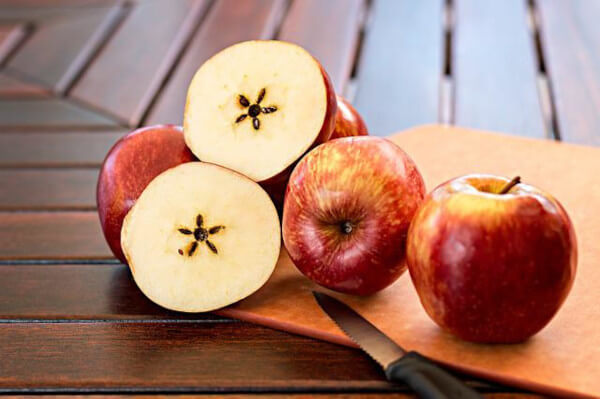
Mabon Colors
As for the colors associated with Mabon, we should think of seasonal autumn colors like:
- Dark brown
- Copper
- Orange
- Deep green
- Dark red
- Dark yellow
- Earth tones
Mabon Spells & Magical Works
Mabon rites can involve adorning your altar with apples, acorns, pinecones, seasonal fruits and nuts, and a few of the first colorful leaves that fall from the trees. If you collect in the woods, don’t be greedy; always leave enough fruit and berries for the birds and small animals.
It is customary to use altar coverings and candles in autumnal hues like rusty red, orange, brown, and gold. Scents include sage, cinnamon, citrus, and apple. Dark-colored crystals, particularly those in tones of green or brown, will offer a positive energy. Make it appear inviting, attractive, and festive.
Light a yellow or orange candle on your altar and give thanks for your safety, happiness, and good fortune.
If you don’t have a dedicated table for the altar, you may create an altar anywhere you have room, such as your kitchen table, windowsill, dresser, or fireplace. An altar can be used for meditation, spiritual rites, or just quiet thinking.
Another idea is to build a shrine outside for the nature spirits to thank them for all the good things they have given you. As a present, leave one of each flower, fruit, and vegetable you have.
Now is a good time to do spellwork for protection and safety, as well as for self-confidence, prosperity, harmony, and balance. Mabon is a great time to set goals that involve lessening or cutting back, like ending bad relationships, bad habits, or self-destructive ways of thinking.
You may create and charge a talisman for this reason to help you get through the following seasons.
Mabon Sacred Plants & Herbs
During the autumnal equinox, several plants are highly valued, including burdock, dandelion, butterfly weed, angelica, and licorice. This is the ideal moment to enlist them and consider them as medicinal companions throughout the winter months since the roots are currently at their healthiest and best prepared to support the plants till spring.
Other important plants for this occasion are,
| Sage | Sunflowers | Pomegranate |
| Bay Laurel | Rosemary | Honeysuckle |
| Grapes | Yarrow | Mugwort |
| Rosehips | Thistle | Ash |
| Marigold | Oak | Maple |
Mabon Deities
Mabon is related to all wine deities, most notably Dionysus and Bacchus, as well as aging deities.Additionally, Demeter, a prime example of the Goddess’s motherly side, Persephone, the Underworld’s queen and Demeter’s daughter, and Thor might all be highlighted.
Some other Autumn Equinox deities include:
Goddesses – Arawn, Ashtoreth, Ceridwen, Epona, Freya, Hathor, Inanna, Ishtar, Isis, Kore, Modron, Morgan, Venus, Pomona, and the Muses.
Gods – Cernunnos, Dagda, Dumuzi, Green Man, Mabon ap Modron, Thoth.
Mabon Crystals
Numerous crystals are associated with Mabon. These include, but are not limited to:
| Carnelian | Sapphire | Orange Calcite |
| Citrine | Sunstone | Ruby |
| Aragonite | Peach Selenite | Peach Moonstone |
| Amber | Aventurine | Tiger’s Eye |
| Jasper | Garnet | Pyrite |
| Quartz | Gold | Cat’s Eye |
Mabon Runes



Jera – Harvest: This symbolizes the period when you can take pleasure in the results of your labor. It serves as a reminder that everything has a cycle or process.
Gebo -Gratitude: It is a symbol of the power of gratitude to inspire more generosity and the energy that comes from giving and receiving gifts.
Fehu – Abundance: this symbol denotes abundance, riches, security, and fertility.
End Words
That concludes our article on Mabon. In a concise way, I tried to cover its origins, its symbols, the ways you can celebrate it, and its correspondences.
It is difficult to remember all these details. So bookmark this page and come back as often as you like.
If you think other people might benefit from reading this, please forward it to them so they can learn more about this celebration. They will definitely appreciate it.
Do you want to learn more about Wicca and Witchcraft? Check out our recommendations at “Wiccan Bookshelf”
Stay in Touch
 Join our newsletter by using the forms on this website or click here!
Join our newsletter by using the forms on this website or click here! Follow us on Google News
Follow us on Google News Follow us on Facebook
Follow us on Facebook
Featured Image by Jill Wellington from Pixabay






